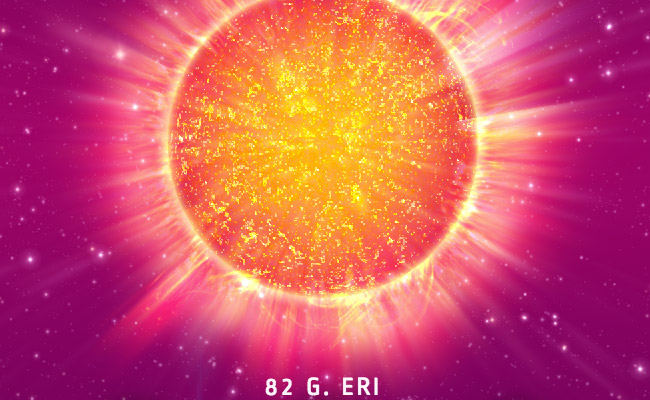82 G. Eridani – Star Facts

In 2011 82 G. Eridani had three planets discovered in its orbit. Each one is considered a ‘super-Earth’ roughly a few times Earth’s mass. They orbit at a rate of about 90 days each, which tells us they are relatively close to 82 G. Eridani. Uranometria Argentina is the Southern-sky catalogue where this star was first listed in the 19th-century by astronomer Benjamin Gould.
Constellation Home
82 G. Eridani is the 82nd star found in the Southern part of the constellation Eridanus and is also known as, HD 20794, HR 1008 and e Eridani. It is located approximately 20 light-years from Earth; 117 trillion miles (188 trillion kilometers). In addition, this star is also situated in a region of space with low interstellar matter; gas, dust and cosmic rays.
Observation
Although 82 G. Eridani is only about 20 light-years away, it may be difficult to see without the aid of a good telescope. It was one of the targets of study with both NASA’s Terrestrial Planet Finder (TPF) and the Space Interferometry Mission (SIM). However, both these programs have been postponed indefinitely.

Star Characteristics and Features
This star is considered a main-sequence star or a dwarf. It is similar to our Sun with its yellow-orange appearance, although it is smaller and with less mass. 82 G. Eridani is also a high-velocity star, meaning it spins faster than the average star, having a true space velocity of about 129.7 kilometers/second (80 mile/second). In addition, due to its age, 82 G. Eridani is relatively metal-deficient and is thought to be an old disk-star.
Brightness of the Star
This star is dimmer than our Sun and shines with an apparent magnitude of 4.254. Because 82 G. Eridani is a main sequence yellow-orange dwarf it is given a spectral (and probable) luminosity of G8 H; however, it is classed as a yellow G5. This star was once thought to be quite bright for its classification and in fact, was the brightest star listed in the 1964 catalogue of high-velocity stars.
History and Mythology
Uranometria Argentina is the Southern-sky catalogue where 82 G. Eridani was first listed in the 19th-century by astronomer, Benjamin Gould. He listed the stars found in this southern celestial hemisphere based on the famous Flamsteed catalogue (uses numbers instead of Greek letters). In addition, this star has also retained its Gould destination (stars are numbered in each constellation in increasing order of right ascension).
In 2011 this star had three planets discovered in its orbit. Each one is considered a “super-Earth;” roughly a few times Earth’s mass. They orbit at a rate of about 90 days each, which tells us they are relatively close to 82 G. Eridani.
Although, there is no mythology associated specifically with this celestial body, it is still an interesting star to search out in the night sky.
